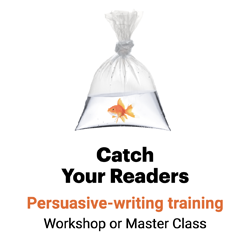Put your story into a nutshell in the nut graph
If I came to your house and told you to grab your things and follow me, how far would you go? To the front door? The driveway? Would you hop in my car without further explanation?

No matter how dazzling your feature lead, at some point, readers want to know where we’re going with this story.
And that’s the job of the nut graph. The nut graph is where you reveal your destination and convince your readers to come along for the ride. (This, by the way, is the nut graph for this story.)
Here are four tips for cracking the nut graph:
1. Tell ’em what you’re going to tell ’em.
Remember the old writing guideline, “Tell ’em what you’re going to tell ’em; tell ’em; then tell ’em what you told ’em?” The nut graph is where you tell ’em what you’re going to tell ’em.
The nut graph — aka the “billboard” or the “so-what graph” — puts the story into a nutshell. It provides the kernel, or central theme, of your story.
“The most important thing in the story is finding the central idea,” says Thomas Boswell, a Washington Post sports columnist.
“Once you find that idea or thread, all the other anecdotes, illustrations, and quotes are pearls that hang on this thread. The thread may seem very humble, the pearls may seem very flashy, but it’s still the thread that makes the necklace.”
2. Summarize your idea in a sentence or two.
A thread may be humble, but it’s also slender and inconspicuous. We’re not talking about stuffing all the W’s and the H into a thick paragraph. Rather, the best nut graphs synthesize the story and answer the readers’ two most burning questions:
- What’s the point of this story?
- Why should I care?
If you can’t summarize your story angle in a couple of sentences, you probably don’t haven’t figured out what it is yet.
3. Show in the lead, tell in the nut graph.
It’s the best one-two punch for starting a story: Grab readers’ attention in the lead, then deliver your point in the nut paragraph.
“Think of the lead as a close-up,” counsels Chip Scanlan, affiliate faculty member at The Poynter Institute. “The nut graph is a wide-angle shot.”
It’s counterintuitive, but it works: Show in a concrete lead; tell in an abstract nut graph. Here’s how it works …
| Show in the lead | Tell in the nut graph |
| Next time you bite into a Vlasic pickle, order the shrimp platter at Red Lobster or squeeze a melon at the A&P, you’ll be enjoying the bounty of Chestnut Hill Farms. | Chestnut Hill Farms, a wholly owned subsidiary of Seaboard Corp., is the company’s produce and seafood arm. … |
| A 45-year-old couple making $160,000 a year today may need as much as $4 million at retirement to live comfortably throughout their lifetime. | It’s never too early to plan for retirement. |
| An embeddable tooth implant sends patient information to a dentist in real time.
A smart watch responds to touch to help ease the loneliness of long-distance relationships. A bracelet records daily physical activity and caloric intake and provides recommendations to achieve health goals. |
These capabilities may have seemed like a dream only a decade ago but are now a reality, thanks to the Internet of Everything. |
4. Tell readers why it’s important to read this story now.
The nut graph is where you make a promise to your readers: “If you read this, you will learn …” That makes this a great place for a WIIFM.
Don’t drop the nut graph.
Writing a nut can be a pain in the b*tt. But don’t let that stop you.
Every feature-style story needs a nut graph. (And, as regular readers of this column know, the feature-style story structure has been proven in the lab, again and again, to outperform the inverted pyramid on virtually every metric.)
“Sometimes, lack of a nut graph signifies a bigger problem,” writes business journalist Michelle V. Rafter. “If a writer has trouble figuring out what to say in a nut graph it could be because they haven’t figured out what the story they’re writing is about.”
Stuck? Try telling a friend who knows nothing about the story what it’s about. Then capture that summary in your story.
That strong nut graph is essential. Because you can’t expect readers to follow your story without one.

Leave a Reply